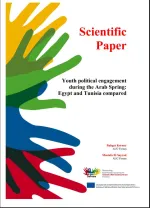Youth political engagement during the Arab Spring: Egypt and Tunisia compared

SAHWA Scientific Paper nº. 9
This Scientific Paper aims at highlighting youth political engagement during the Arab Spring – the peak of explicit, direct and mass “youth involvement in politics”. This exceptionally high involvement did not continue to be institutionalised. In fact, the earlier mass political participation contrasts at present with a certain political marginalisation of former activists/youth leaders. The logical research question is then: what accounts for such two extremes?
To analyse this evolution from one extreme to the other, this paper adopts a comparative approach between the two seemingly similar cases of Egypt and Tunisia. These two countries are different in some respects: Egypt has nine times the population of Tunisia, for example, and the two countries’ recent colonial past has been influenced by different sociopolitical traditions: Anglophone and Francophone. However, for the subject of this paper they share the status of being the pioneers of the Arab Spring.
To carry out its comparative methodology and especially to decode the youth political participation problematic from one extreme to the other, the paper utilises the SAHWA Project data 2015/16, both qualitative and quantitative. Since these data have to be situated within each country’s national context, the paper uses also some other sources, when required.
In terms of organisation, the paper’s 22 tables reiterate the primacy of the “youth bulge” that the two countries share: the available data unequivocally shows for instance that unemployment is number one as a cause of concern. However, unemployment is treated here not only as an economic aspect but also as one that
Youth political engagement during the Arab Spring: Egypt and Tunisia compared leads to political discontent, as well as increasing mistrust of state institutions, a mistrust that results in the present political withdrawal, at least at the formal level. In the last part before concluding, the paper uses other field data from Egypt to investigate the challenges facing youth political participation, including young people’s lack of experience of using institutionalised political machines. The paper concludes by drawing attention to other unconventional aspects of civic engagement/political participation and presents a table comparing the similarities and differences between Egypt and Tunisia.
DOI: doi.org/10.24241/swsp.2017.9.1
E-ISSN: 2564-9183